
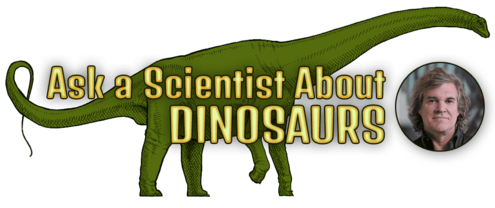
Mark Norell answers kids' questions about dinosaurs. He’s a paleontologist at the American Museum of Natural History.
Mark Norell: The biggest fossil dinosaurs I've ever found are sauropods from Central Asia as well as from the American West. These animals are related to the Apatosaurus and Mamenchisaurus. Mamenchisaurus is a giant sauropod from Central Asia. These plant-eating animals had fantastically huge, long necks and were the heaviest and longest dinosaurs ever found. Sauropods were the biggest animals ever to walk Earth .
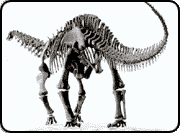
The Apatosaurus specimen from the Museum's Hall of Saurischian Dinosaurs.
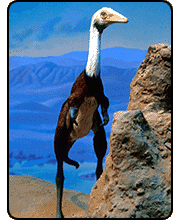
A recreation of the Shuvuuia in a Museum exhibition.
Mark: The weirdest fossil dinosaur I've ever found had to be Shuvuuia, a relative of Mononykus. It's weird because no one would ever have imagined an animal that looked like that would have ever lived. It had really powerful, but extremely short forelimbs. These theropod dinosaurs had bodies about the size of a goose, but with long legs. Shuvuuia and Mononykus were both discovered in Mongolia , and had feathers. They were both birds, but they really didn't look like them.
Mark: Probably the most interesting dinosaur fossil I ever found is the nesting Oviraptor. This fossil really tells us something special about the past: that these animals looked and behaved like birds. The specimen found where the adult Oviraptor is positioned on a nest of eggs is compelling evidence that these animals behaved like parents in a very bird-like way. This behavior, coupled with such birdlike characteristics as a toothless beak and possibly feathers, strengthens the bird-dinosaur connections even more.
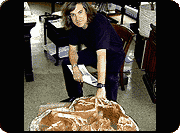
Mark Norell points to the specimen of a nesting Oviraptor in his office.
Mark: Not all fossil bones are alike. Some fossil bones that are 60 or 70 million years old have a lot of their original chemical composition. They almost seem more like bone than rock. Other fossil bones could be "just" 10,000 years old, but they're so hard you could drive nails with them. How long it takes depends on the conditions the bone is buried in. Here's a tip. When you find a fossil bone, you already know something about the animal. You know it must have been buried very quickly. Why? Bones left exposed for long would decay. After an animal is buried, the specific conditions of the local environment come into play.
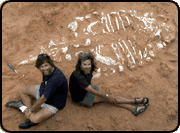
Luckily, this fossil of an ankylosaur that Mark and Mike Novacek found in the Gobi Desert made it through the fossilization process and survived in one piece.
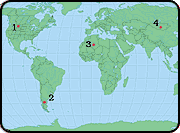
Mark: So far, there are really only four great places in the world to collect dinosaur fossils.
- The American West (much of the collection we have at the Museum was collected from Montana).
- Patagonia in Argentina (this area is now being explored by paleontologists, including some from my Museum).
- Africa, at the edge of the Sahara desert.
- Mongolia in Central Asia.
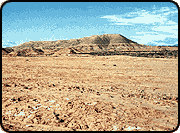
The badlands of Argentina are a popular spot for collecting dinosaur fossils.
Mark: First, they are in the middle of very stable continents. A stable continent is one without a lot of earthquakes , volcanic eruptions, or other major geological events that would destroy the fossils. Second, they have the kinds of landforms that preserve fossils well, such as badlands. In badlands, the forces of erosion, such as wind and water , have exposed layers of rock that contain fossils.
Mark: Yes! Every few weeks somebody describes a new one. We just described one. When an unknown dinosaur is found we write a detailed report on what we have discovered. This report is know as a 'description.' Paleontologists usually name the dinosaur in their description. Certainly on our next field trip we'll find a new one. There are many more dinosaurs waiting to be found than have been found. A lot of these have been collected and are in museum collections. They just haven't been studied yet.
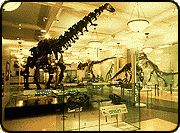
The Museum's Hall of Saurischian Dinosaurs, with Apatosaurus on the left.
Mark: All dinosaurs didn't become extinct because modern birds are, in fact, dinosaurs. There are scientists in our Ornithology Department who are investigating the 15,000 species of birds alive today. That's 15,000 different kinds of living dinosaurs! So get some binoculars and go dinosaur watching. Now, let's talk about why the non-bird dinosaurs became extinct about 65 million years ago. The answer is: we don't know. That question is unanswerable based on the fossil record. I have no doubt a big meteorite hit Earth about 65 million years ago, but it's very hard to directly connect this event to the great dinosaur extinction.
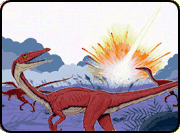
This illustration, by Museum illustrator Ed Heck, shows what it might have looked like if an meteorite hit Earth during the age of dinosaurs.
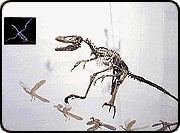
Just as humans are both primates and mammals because we descended from the first primate and the first mammal, birds are both theropods and dinosaurs because they descended from the first theropod and the first dinosaur.
Mark: Like most discoveries in science, it wasn't a sudden realization like a light bulb going on but the gradual gathering of evidence and observations. So, the idea that modern birds are related to dinosaurs is pretty old. In the 1850s, scientists who examined skeletons noticed a great degree of similarity between birds and traditional dinosaurs. Then this idea lost favor until the 1960s when we had better methods for analyzing the evidence and creating a family tree. Since the 1960s, many pieces of evidence that have been discovered support the idea that birds are descendants of certain dinosaurs that lived millions of years ago.
Mark: Think of it this way. Or draw it. If every animal that has feathers has a backbone but all animals with a backbone don't have feathers – what we're are saying is that both feathered and non-feathered animals come from a common ancestor with a backbone. The simplest explanation is usually the right one. Why? Think about it. Is it likely that feathers evolved 15,000 different times in each kind of bird species? Feathers evolved once, and all feathered creatures descended from that first feathered animal, changing other characteristics in response to its environment.
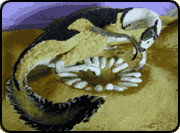
This feathered model from a Museum exhibition shows how an oviraptorid dinosaur may have looked when it was alive.
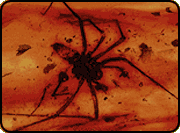
Some science fiction proposes cloning dinosaurs from the traces of their blood found inside the bodies of biting insects fossilized in amber. This amber specimen has a spider trapped inside.
Mark: Cloning is a complicated issue. Here's as simple an answer as I can give. To clone an animal, you need the complete genetic code, the blueprint of how the animal is constructed. The genetic code is huge and complex. It consists of long strands of DNA which generally don't survive the fossilization process. Even if we did have the genetic code for extinct dinosaurs, the technical aspects of creating an embryo and growing it are virtually impossible.
Image Credits:
Apatosaurus illustration, by Sean Murtha © AMNH. All other photos courtesy of AMNH.




 Biodiversity
Biodiversity
 Brain
Brain
 Genetics
Genetics
 Marine BiOLogy
Marine BiOLogy
 MicrobiOLogy
MicrobiOLogy
 PaleontOLogy
PaleontOLogy
 ZoOLogy
ZoOLogy
 AnthropOLogy
AnthropOLogy
 ArchaeOLogy
ArchaeOLogy
 Astronomy
Astronomy
 Climate Change
Climate Change
 Earth
Earth
 Physics
Physics
 Water
Water
